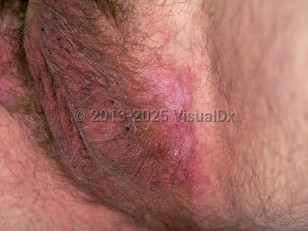Extramammary Paget disease
See also in: AnogenitalAlerts and Notices
Important News & Links
Synopsis

Extramammary Paget disease (EMPD) is a rare neoplastic condition that usually occurs in the sixth to eighth decades of life. EMPD may be primary and arise as a cutaneous adenocarcinoma, or it may be secondary, due to extension of an underlying contiguous or noncontiguous adenocarcinoma. Approximately 10%-25% of patients have a contiguous malignancy at the time of diagnosis. An additional 10% of patients with a new diagnosis of EMPD are diagnosed with a noncontiguous malignancy within 12 months of diagnosis. The most commonly associated malignancies are cancers of the colon, genitourinary tract, and breast. Associated carcinomas of the cervix, vagina, endometrium, bladder, and Bartholin glands have also been described. Due to these associations, a thorough investigation for underlying malignancy should accompany every diagnosis.
The condition is most often seen in elderly White women, but males are more likely to be diagnosed with this condition in Japan. Mutations in the CDKN2A gene have been reported to be causative in some patients and, when present, are associated with poor prognosis.
Clinically, lesions most commonly appear on the vulva in women and in the perianal area in men. Lesions are often banal in appearance and can resemble eczema, leading to delays in diagnosis. Symptoms may be minimal to none; often, there is itch, pain, or burning. Presentation is typically of a red, sharply demarcated plaque that expands slowly. Areas within the plaque are marked by erosions and white scale, leading to the appearance of "strawberries and cream." EMPD is thought to invade and metastasize via lymphatics.
The condition is most often seen in elderly White women, but males are more likely to be diagnosed with this condition in Japan. Mutations in the CDKN2A gene have been reported to be causative in some patients and, when present, are associated with poor prognosis.
Clinically, lesions most commonly appear on the vulva in women and in the perianal area in men. Lesions are often banal in appearance and can resemble eczema, leading to delays in diagnosis. Symptoms may be minimal to none; often, there is itch, pain, or burning. Presentation is typically of a red, sharply demarcated plaque that expands slowly. Areas within the plaque are marked by erosions and white scale, leading to the appearance of "strawberries and cream." EMPD is thought to invade and metastasize via lymphatics.
Codes
ICD10CM:
C44.99 – Other specified malignant neoplasm of skin, unspecified
SNOMEDCT:
254727007 – Extramammary Paget's disease of skin
C44.99 – Other specified malignant neoplasm of skin, unspecified
SNOMEDCT:
254727007 – Extramammary Paget's disease of skin
Look For
Subscription Required
Diagnostic Pearls
Subscription Required
Differential Diagnosis & Pitfalls

To perform a comparison, select diagnoses from the classic differential
Subscription Required
Best Tests
Subscription Required
Management Pearls
Subscription Required
Therapy
Subscription Required
References
Subscription Required
Last Reviewed:10/13/2024
Last Updated:01/14/2025
Last Updated:01/14/2025
Extramammary Paget disease
See also in: Anogenital
